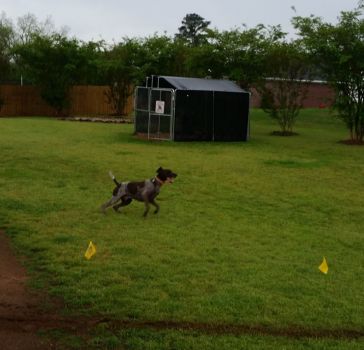
Central Alabama:
(205) 444-3644
Birmingham
North Alabama:
(256) 504-3469
Huntsville & Gadsden
Southeast Alabama:
(334) 757-0069
Montgomery & Auburn
Spring Sale - $200 off our regular price and 50% off additional wire beyond 500 feet!
Alabama Dog Guard Serving North, Central, and Southeast Alabama.
If you have a dog that doesn't want to go out of the house or is sticking close to the house, be patient. Time is your best friend. The more sensitive your dog is, the longer it will take him to explore the yard. Eventually, your dog will use the whole yard.
The main problem with this scenario is that your dog's enthusiasm is very low and his containment is very high. Your job is to get his enthusiasm back up. Here are some tips that will help you work through this challenge:
Try and limit the number of corrections your dog gets. Right now your dog is "over contained." Don't play with him near the boundary or do anything to coax him towards the edge. Another correction at this point will only discourage him from using the yard. Because some dogs can't tolerate more than one correction every two days, try and extend the amount of time between corrections.
If your dog has run through the fence more than twice, his desire to get out is greater than his concern for the correction of the fence. To solve this break out problem you can either turn off the transmitter or take off his Dog Guard receiver collar. This will allow the dog to come back through the perimeter without getting shocked. Put the collar back on the dog once he's inside his boundary.
If your dog acts like he doesn't feel the correction it is for one of two reasons. Either his collar is too loose, or there is too much hair between the probes and his skin. In both cases he will not feel any correction. To remedy this, try adjusting the collar. If that doesn't work, try trimming the fur directly beneath the probes.
If you have a dog that runs through the fence more than three times, call Alabama Dog Guard immediately. Adjustments may have to be made in either the receiver or the field. Please call your us before attempting to make any changes to your transmitter settings.
To ensure a consistent signal, the dog's collar must be secured as illustrated above. To do this, make sure the probes are closest to the dog's chest so that the receiver hangs down at a slight angle in the front.
It is important to periodically check the size and fit of your pet's nylon collar. As he grows, the collar's size will have to be adjusted to provide a secure, comfortable fit. You want the prongs to be touching the skin of the neck, but still be loose enough to get one finger between one of the prongs and the dog's skinIn all three methods you must take the dog's receiver collar off. If you don't take the collar off and you enter the correction zone of a house that has a Dog Guard fence, your dog will get a correction. It is important that you remove the collar instead of turning the fence off at the transmitter.
Simply pick your dog up and carry him through the perimeter. Please only use this if you have a small dog and you can safely lift and carry him. Put the dog down once you have generously passed the barrier. Use the same maneuver when returning through the fence.
Put your dog in the car and drive through. Much like the pick up method, but a little less strenuous for large hound owners.
From the day your fence is installed, follow the same route when taking your pet out of the yard, making sure to leave and enter the yard in the same spot each time. If this is done consistently before and during training, your pet will associate you, the leash, and the route as a safe means of leaving the yard.
Interested in learning more? Get a fast quote with no on-site visit needed!
Get a Free Quote“Wonderful experience very professional made sure we understood how to train our dogs and the follow up is amazing!!! I highly recommend!”

“Crystal and Shane Moore’s dog, Frank, loves to run! They looked us up online and say that Frank is now doing great. “We love the fence!””